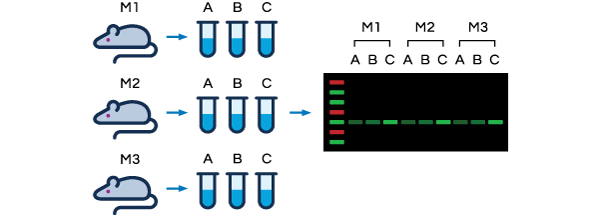“Authors must state the number of independent samples (biological replicates) and the number of replicate samples (technical replicates) and report how many times each experiment was replicated.”[1]
Both biological and technical replicates are key to generating accurate, reliable results and help address different questions about data reproducibility.
Technical Replicates
Technical replicates are repeated measurements of the same sample that demonstrate the variability of the protocol. Technical replicates are important because they address the reproducibility of the assay or technique; however, they do not address the reproducibility of the effect or event that you are studying. Rather, they indicate whether your measurements are scientifically robust or noisy and how large the measured effect must be in order to stand out above the background noise.[2] Examples may include loading multiple lanes with each sample on the same blot, running multiple blots in parallel, or repeating the blot with the same samples on different days.

When technical replicates are highly variable, it is more difficult to separate the observed effect from the assay variation. You may need to identify and reduce sources of error in your protocol to increase the precision of your assay. Technical replicates do not address the biological relevance of the results.
Biological Replicates
Biological replicates are parallel measurements of biologically distinct samples that capture random biological variation, which can be a subject of study or a source of noise itself.[3] Biological replicates are important because they address how widely your experimental results can be generalized. They indicate if an experimental effect is sustainable under a different set of biological variables.
For example, common biological replicates include repeating a particular assay with independently generated samples or samples derived from various cell types, tissue types, or organisms to see if similar results can be observed. Examples include analysis of samples from multiple mice rather than a single mouse, or from multiple batches of independently cultured and treated cells.

To demonstrate the same effect in a different experimental context, the experiment might be repeated in multiple cell lines, in related cell types or tissues, or with other biological systems. An appropriate replication strategy should be developed for each experimental context. Several recent papers discuss considerations for choosing technical and biological replicates.[1,2,3]
For a helpful guide in choosing and incorporating the right technical and biological replicates for your experiment, check out the Quantitative Western Blot Analysis with Replicate Samples protocol.
Additional Resources to Help You Get the Best Data
LI-COR has additional resources that you can use as you plan your quantitative Western blot strategy.
- Determining the Linear Range for Quantitative Western Blot Detection provides guidelines for characterizing the linear range of detection for your system.
- Housekeeping Protein Validation Protocol walks you through the steps of how to validate that the expression of an HKP is constant across all samples and unaffected by the specific experimental context and conditions. If expression varies, then the HKP cannot be used for normalization.
- Housekeeping Protein Normalization Protocol shows you how to use housekeeping proteins for Western blot normalization, as long as you have validated that their expression does not change under your experimental conditions.
- Revert™ 700 Total Protein Stain Normalization Protocol describes how to use Revert 700 Total Protein Stain for Western blot normalization and quantitative analysis, fast becoming the gold standard for normalization of protein loading.
- Pan/Phospho Analysis for Western Blot Normalization provides guidelines on how to use total and post-translationally modified proteins for Western blot normalization.
References:
- [1] Instructions for Authors. The Journal of Biological Chemistry. American Society for Biochemistry and Molecular Biology. Web. 31 July 2017.
- [2] Naegle K, Gough NR, Yaffe MB. Criteria for biological reproducibility: what does “n” mean? Sci Signal. 8 (371): fs7 (2015).
- [3] Blainey P, Krzywinski M, and Altman N. (2014) Points of Significance: Replication. Nature Methods 11(9): 879-880. doi:10.1038/nmeth.30
- [4] Collecting and Presenting Data. The Journal of Biological Chemistry. American Society for Biochemistry and Molecular Biology. Web. 9 May 2018.
Powered by Froala Editor